I love walking the coast of Cornwall, there’s so many adventures to be had – including EPIC caves!
Cornwall, UK has a 400-mile coastline dotted with fascinating caves. Over millions of years, the salty sea has crashed into the rocky cliffs – resulting in many a secret cavern.
Exploring Cornwall’s caves is sure to be an unforgettable highlight of any visitor’s trip!
The beauty of hollowed rock, combined with the old English myths and mining history, makes for a magical holiday activity.
There’s a cave for every appetite. Whether you’re a casual explorer, a history buff, or a hardcore diver, there’s a Cornish cave that you’ll want to experience.
Want to go spelunking, but don’t know which caves to hit? We’ve compiled a list of the most awe-inspiring, magic-residing caves in all of Cornwall! In this article, we’ll explore:
- Seven of the best caves in Cornwall to check out
- A popular and thrilling pair of activities to try in Cornwall to get your adrenaline pumping.
Bring a torch and keep an eye on the tide, because we’re going in!
Merlin’s Cave
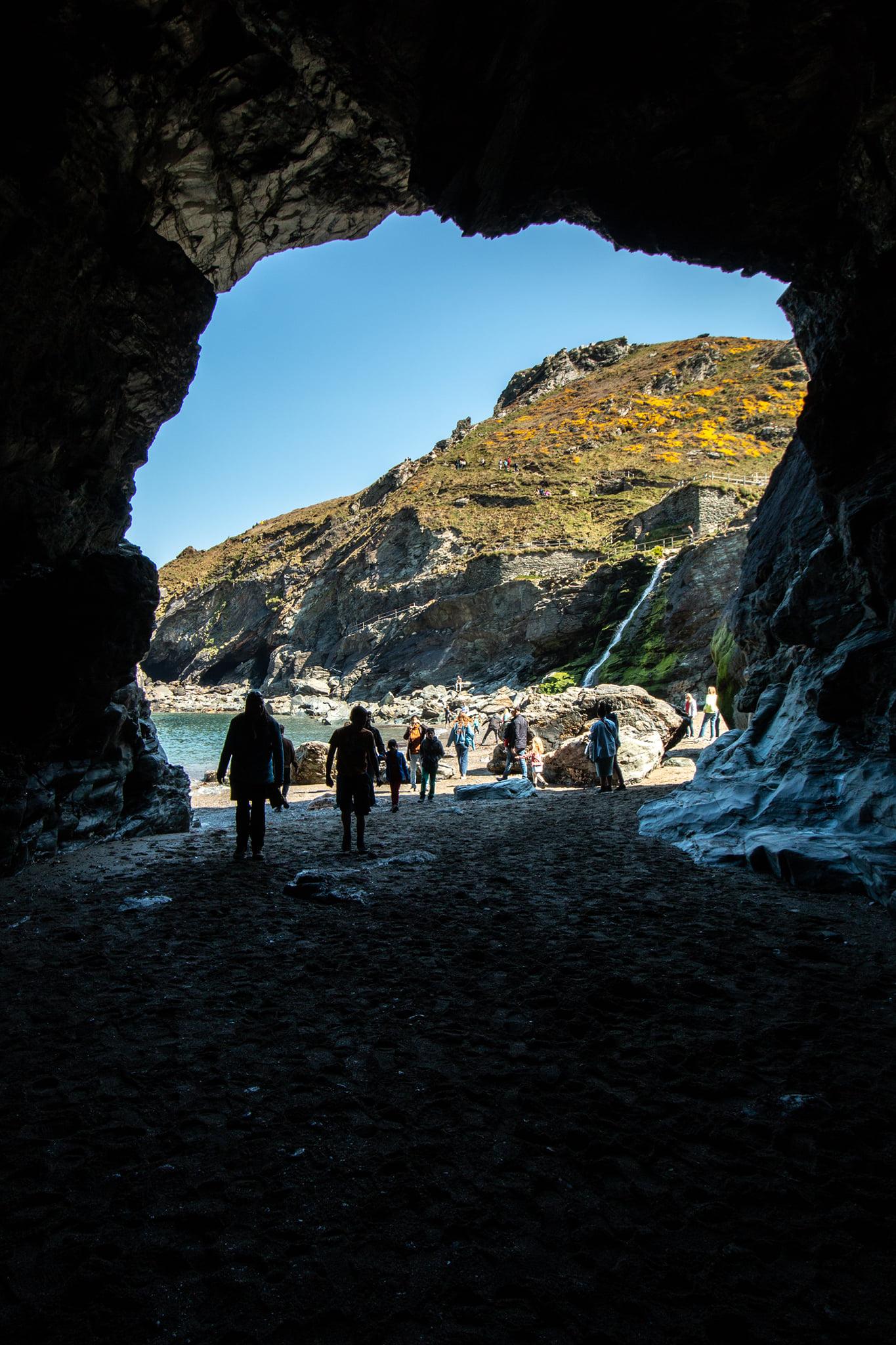
Just a five-minute descent from Tintagel Castle, Merlin’s Cave is a Cornwall favourite. According to legend, Merlin the Wizard resided in the cave, camping out and performing magic.
Wondrous experiences abound in this area. One visitor even claimed to hear a druid playing a recorder inside the cave, dubbing the entire experience as mystical.
Merlin supposedly saw the infant King Arthur wash up in the tides, picked him up, and brought him to safety. Arthur then lived above the cave, in the now-crumbled Tintagel Castle.
The mythology, though now foggy, is still resounding. Local artist Peter Graham honoured the stories by carving Merlin’s face into the rock – the craggy figure of which you’ll see carved at the entrance of the cave.

In terms of accessibility, there are a few factors to keep in mind. It’s a five-minute route from Tintagel Castle to Merlin’s Cave, and the entirety of the walkway is downhill via steps.
It’s quite steep, particularly on the last few steps, so be sure to descend carefully.

Do also keep in mind the tide schedule before heading in, as Merlin’s Cave floods in high tide. It’s also fairly cold and dark in there, so equip yourself accordingly for this adventure!
Carnglaze Caverns
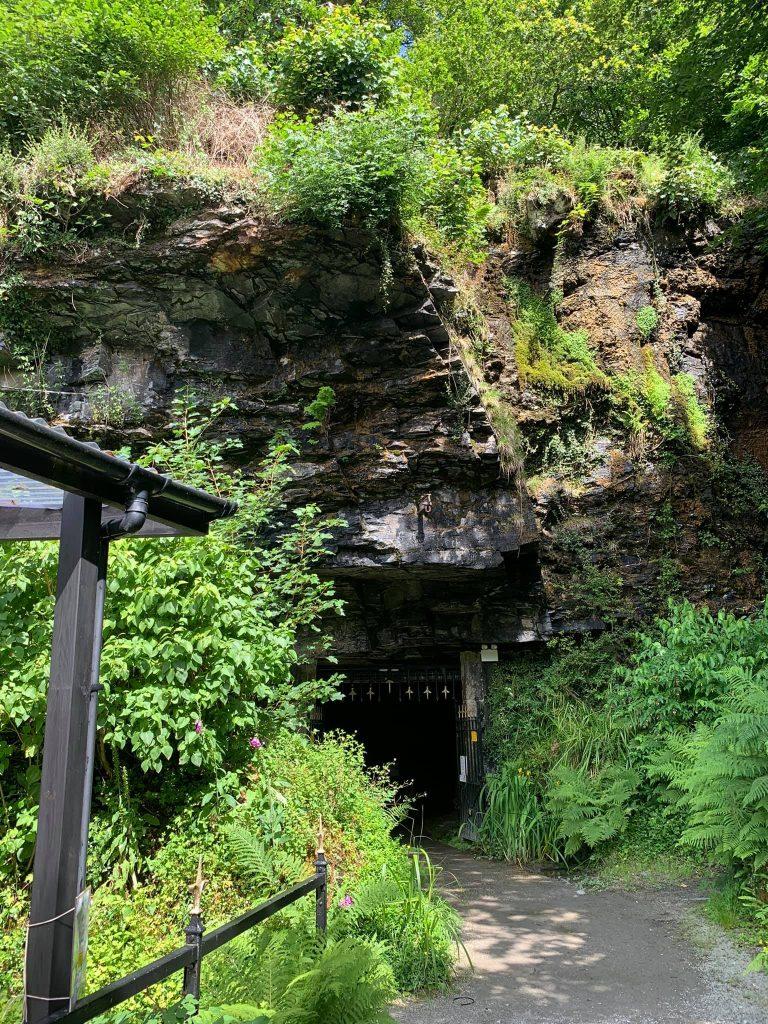
Carnglaze Caverns, of which there are three, make up the only underground slate mine in Cornwall.
The first two are accessible, but the third cave is submerged in crystal clear water, tinted blue-green.
Interestingly, Carnglaze Caverns is where the band “Echo and The Bunnymen” took the photograph for the cover of their 1984 album Ocean Rain. You can see the glowing blue tones of the caverns in the photo.
The caverns are located on the southern side of Bodmin Moor in Loveny Valley, which itself is also inhabited by acres of ancient oak trees. Walk far enough into the woods and you’ll find the cavern entrance.
In Cornwall’s mining heyday, Carnglaze was excavated for slate – a fine-grained rock commonly used for 19th-century roofs.
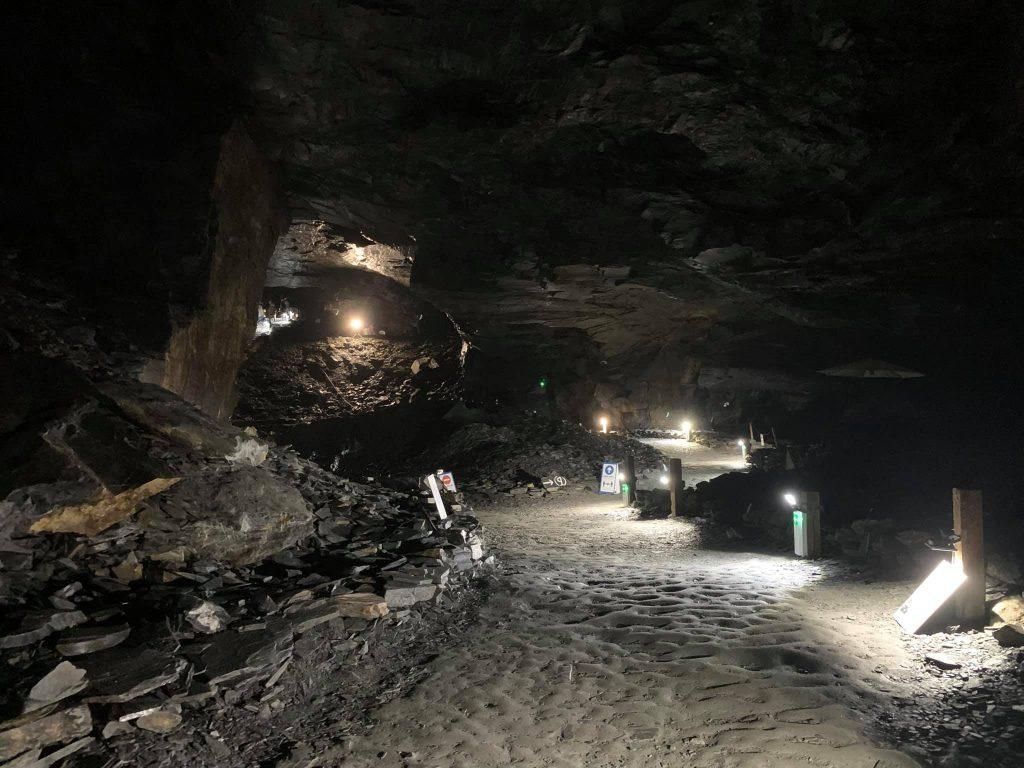
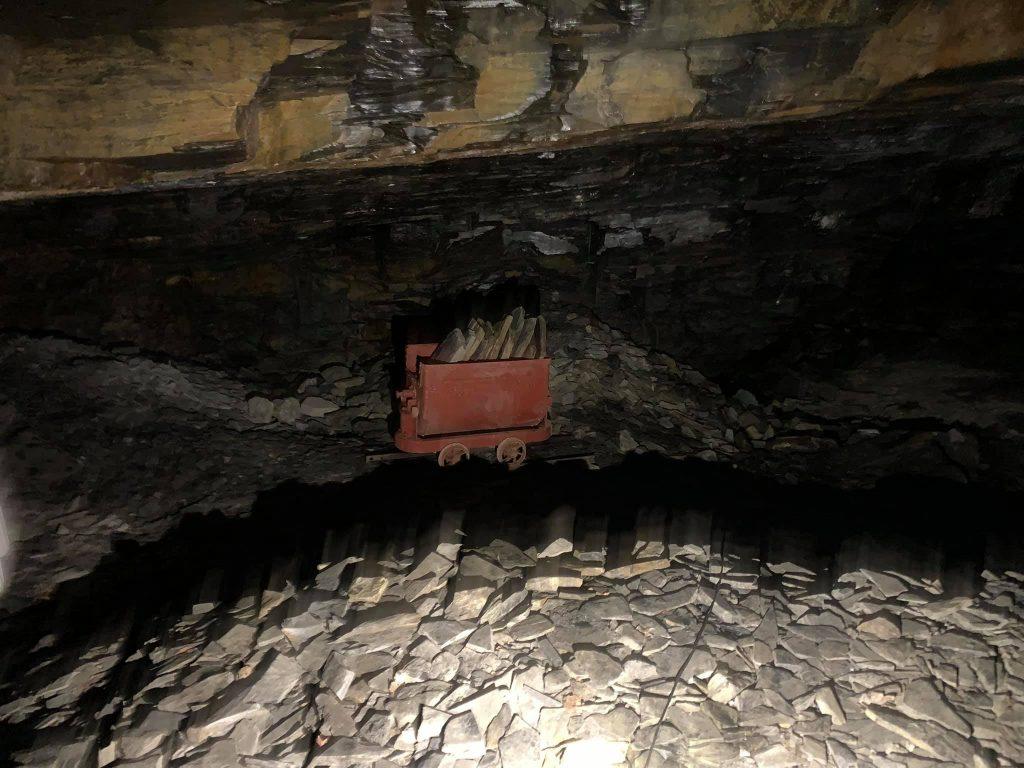
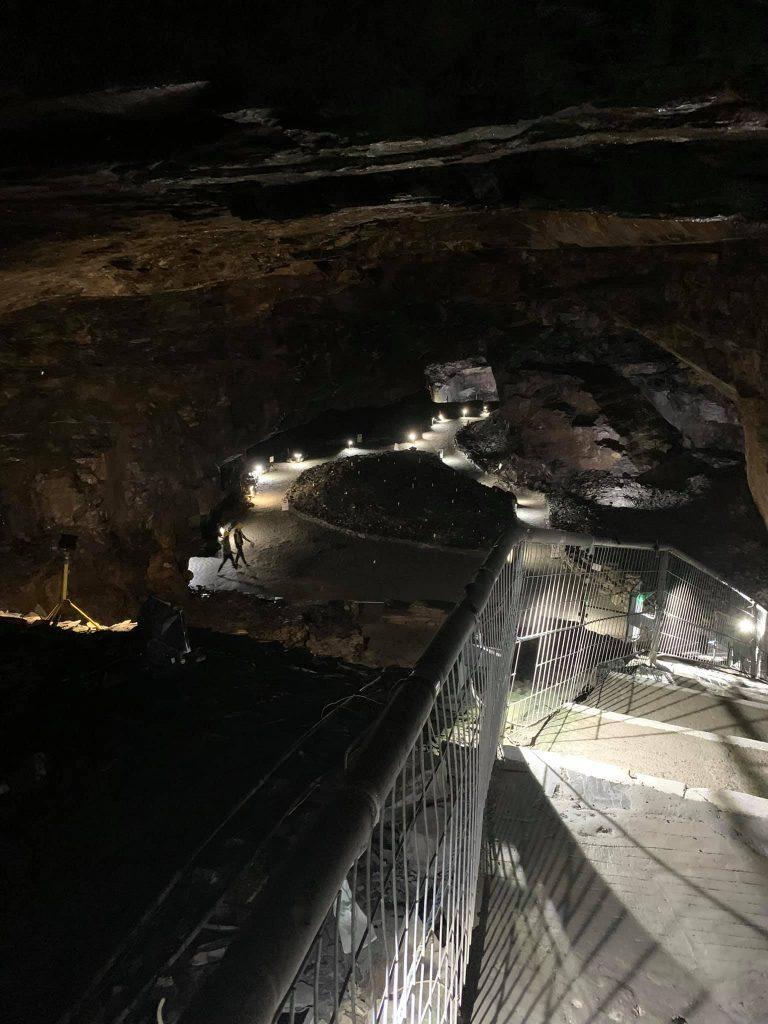
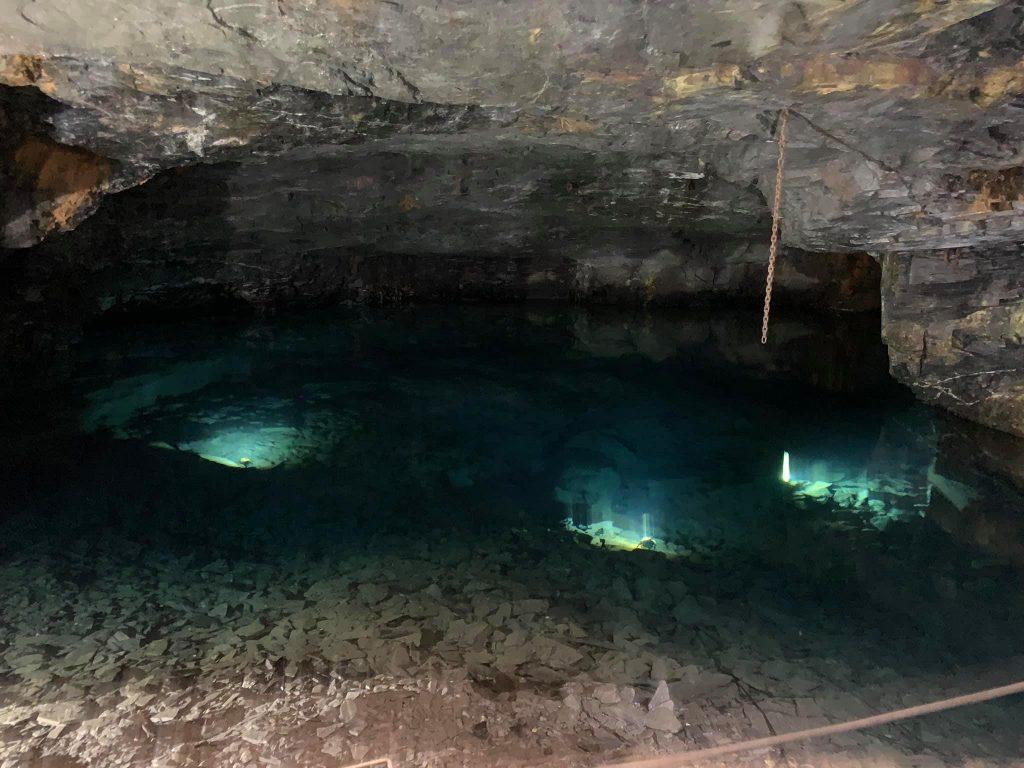

Slate is typically mined in open quarries, but Carnglaze miners went the extra mile by also digging underground using hand tools, forming the three caverns present today.
The first two caverns are accessible on foot and are connected by a 50-step stone staircase.
The third cavern is entirely underwater though still visible. Other shafts used to access minerals like tin and copper are apparent, but they have been closed off for safety reasons.
If you’d like to visit these caves, you’ll have to book ahead for a guided tour! You will be provided with safety gear, but make sure to bring your own warm clothes to account for the cool 10-degree cave climate.
St. Cuthbert’s Cave and Holywell
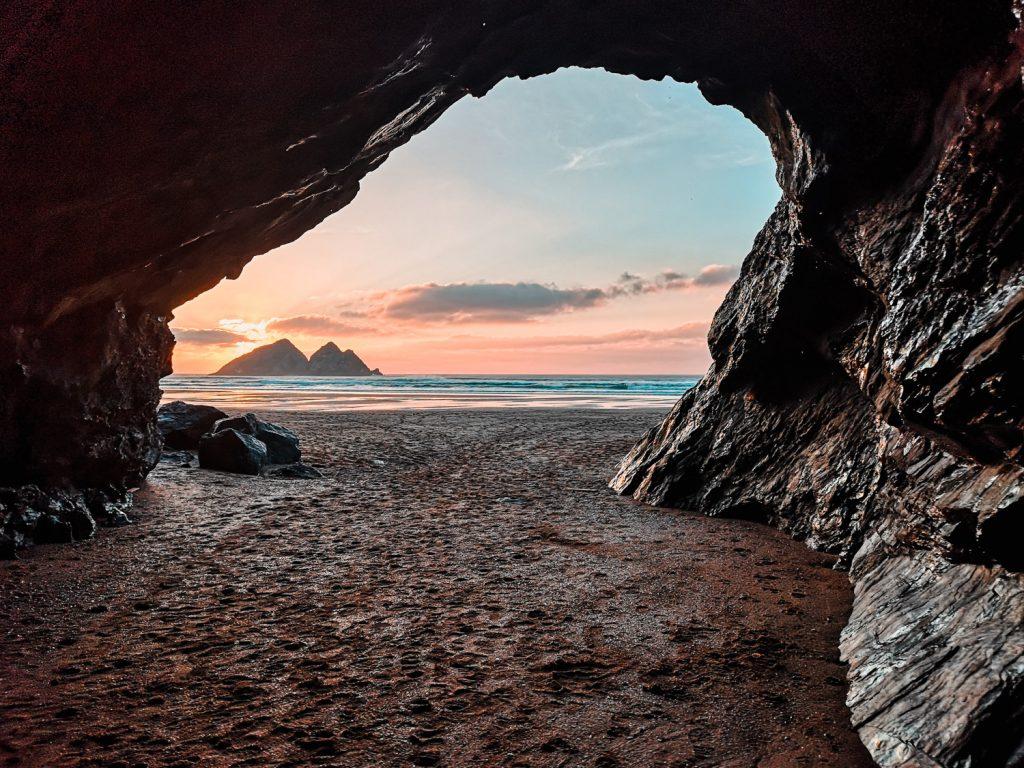
If you walk along the beach at Holywell Bay – one of the most amazing beaches in north Cornwall – (and filming location for HBO’s House of the Dragon and Poldark), you’ll stumble upon many caves in the rock. Some are small and shallow, while others are large enough to enter.
St Cuthberts is one of those larger caves. Inside it, you’ll see gorgeous pink-toned rocks with red, white, yellow, blue, and green veins running throughout. Clear water cascades down a tiered fountain of sorts before running out to sea.
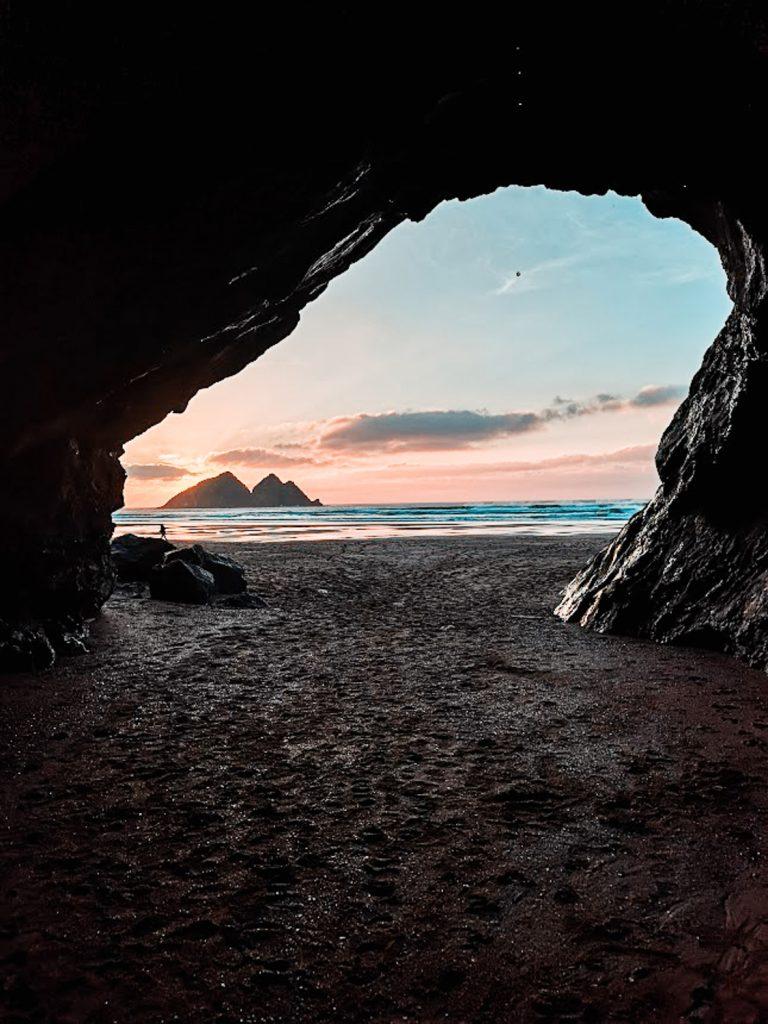
It’s said that this water has healing properties. It has a high calcium content, collected by dripping down a series of rocky pools. For that reason, it might taste a little milky!
For centuries, people with ailments have taken a drink from the holy water in the belief that it would cure their ailments.
Whether you’d be interested in doing the same is, of course, completely up to you. It’s still quite commonly used for baptisms, so it’s certainly not harmful on the skin.
The well is free to access, but note that it can be tricky to find as there’s no sign outside. You’ll have to walk along the beach and peep into each cave until you find it! If you see rainbow rocks and stacked rocky basins, you’ve got the right one.
Be sure to visit at low tide, as the cave is otherwise washed out by the sea. Bring a torch with you to illuminate the colours within.
Crantock Cave
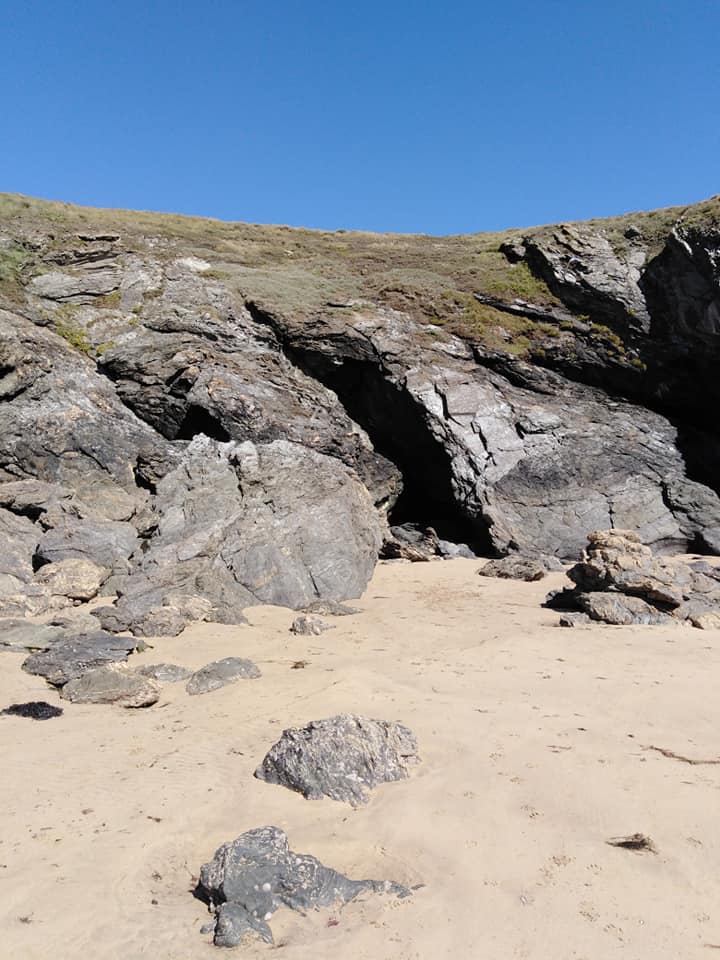
There are many beaches in Cornwall with caves, but Crantock Beach near Newquay stands out in particular.
This area is a flat, golden paradise where the sea rushes up to meet the steep cliffs at high tide. When the tide has receded, you can access the many caves tucked underneath!
The most famous of these in Crantock is Piper’s Hole, known for its impressive carving. On the flat rock face, you’ll see a woman and a little horse carved next to poetry.
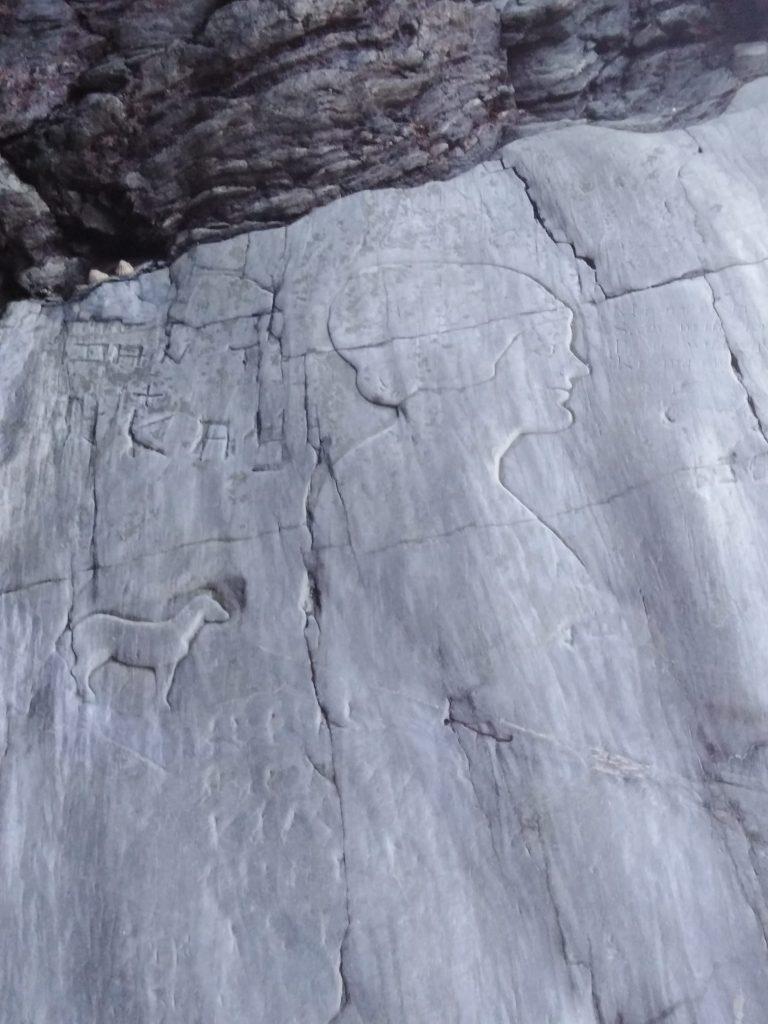
The poem reads:
“Mar not my face but let me be,
Secure in this lone cavern by the sea,
Let the wild waves around me roar,
Kissing my lips for evermore.“
Nobody knows the woman’s identity, but the story goes that she and her horse drowned when they were trapped by the incoming tide. People have speculated that the carver was a local named Joseph, born around 1860.
His full name was Joseph Prater, and according to official records, he did in fact exist. Some say that he was a local artist from a well-to-do family, explaining why the carving was carried out so magnificently.
It’s said that the woman’s lover returned often to the beach in search of her. He visited the cave where he believed she had died and carved the pictures and the poem to honour her.
A past visitor has claimed that Crantock Beach by itself is an unbeatable sight that’s made even more beautiful by the story of the lady and the poem, which they find to be heart-wrenchingly beautiful.
Nobody has been able to conclusively confirm that Joseph, the woman, and her horse truly did experience the events that mythology claims they did.
However, the carving remains on the rock to this day, and in true Cornwall fashion, the story has been kept alive.
The mournful tale is also a good reminder to check the tide schedule — don’t attempt to enter the cave if the tide is coming in! It’s vital to remember that the water always moves faster than you can.
Piper’s Hole, Tresco

Don’t confuse Piper’s Hole, Tresco, with Piper’s Hole in Crantock Cave. The Tresco Piper is a small freshwater pool surrounded by boulders, and is considered one of the best sea caves in Cornwall.
You’ll have to crouch to make it past the entryway boulders. Further along, the ceiling opens up until you find yourself in a little grotto of sorts. The water is about 1.5 metres deep, and there’s a strip of “beach” on the other side.
It’s unclear whether Piper’s Hole was mined or created naturally. Regardless, it’s a highly popular tourist spot! Once upon a time, there was even a little boat in there so you could float your way to the little rock and sand beach.

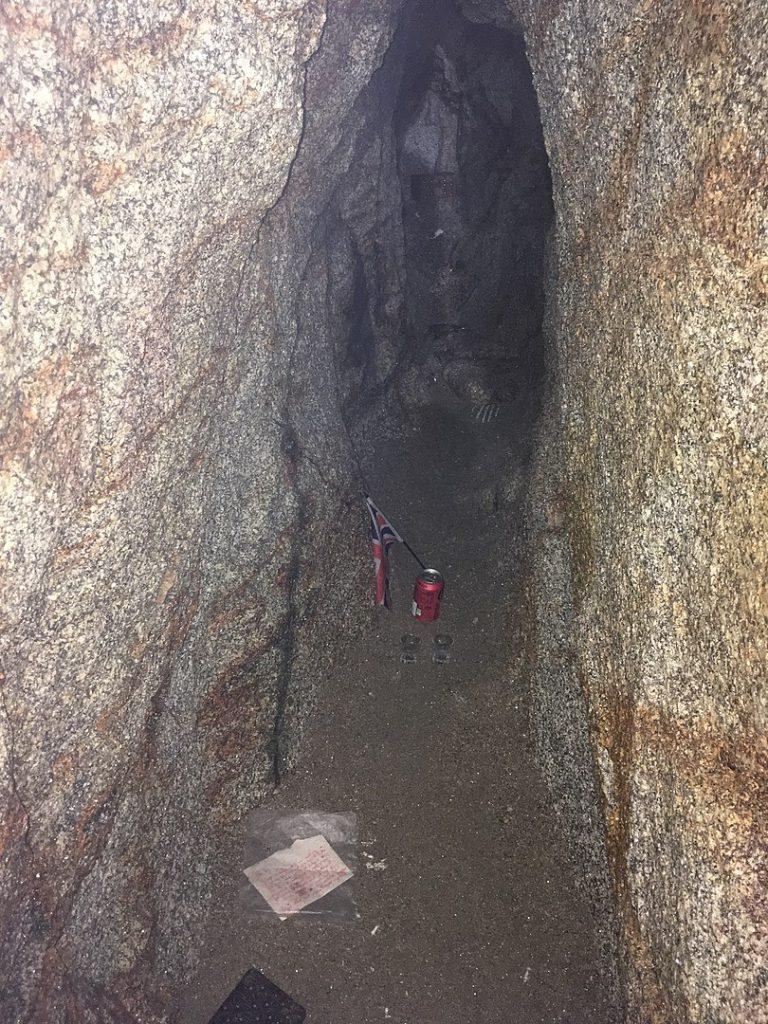
Some people still bring candles into the cave, like they would have done in the olden days. Apparently, the gently flickering light gives off a romantic energy in the grotto.
A word of warning: the cave is difficult to access and can be dangerous to be in, so tread with care. It’s highly recommended to bring a torch and not to venture alone.
As always, check the tides before you enter the Hole! Water rushes in very rapidly, which could catch off-guard you in that “just 5 more minutes!” period.
Prussia Cove

A cove is simply a cave that’s open at the top — and that’s why Prussia Cove has made this list! This picturesque bay is small, beautiful, and a bygone site of illegal smuggling.
The cove itself is situated below green hills topped with little cottages. The rocks reach out to sea in a horseshoe shape, while a patch of stark white sand stretches all the way into the aquamarine blue water.
When you’re at Prussia Cove, it feels like you’re in the past.
As with most Cornwall attractions, there’s a story behind the cove. History tells us that it was home to the Carter family, who were successful 18th-century smugglers.
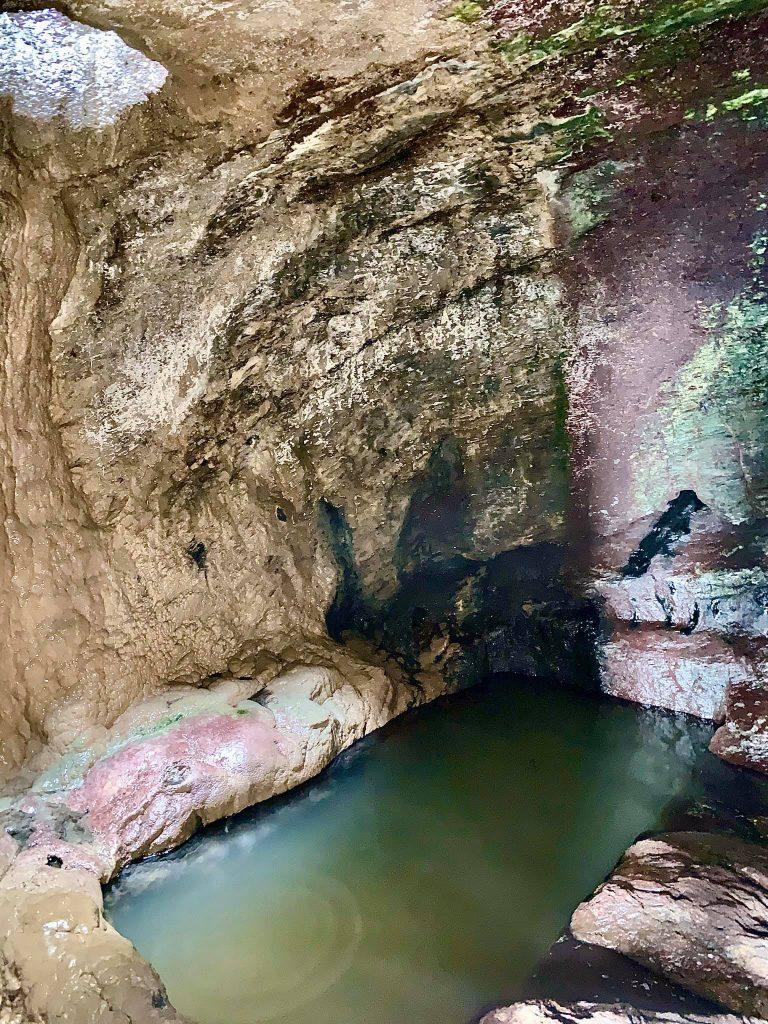

John Carter gave himself the title “King of Prussia” in admiration of the German figure.
He was a prominent smuggler, as was his younger brother Harry – and together, they chose Prussia Cove as boats could dock neatly at the rocks, drop off goods, and depart undetected.
Evidence of smuggling can still be seen in the rock today — there are thick, deep cart tracks running from land to furthermost point. This is how goods (tea, alcohol, etc.) were transported to and fro.
Prussia Cove is a beloved place, even if it was once a site of illegal activity. Cornwall was riddled with smuggler hideouts, and this was one of the busiest and most successful locations.
If you head into the cove, know that it’s extremely secluded and that there are no lifeguards present. It’s not a place that can handle enormous crowds; just enough room for a few smugglers, a boat, and a whole lot of goodies.
Song of the Sea Cave, Nanjizal

A cave would have to be very special to earn the title, “Song of the Sea”. Not one to disappoint, this one sure exceeds all expectations!
Song of the Sea Cave, also known as Zawn Pyg in Cornish, is a swimmer’s dream.
Two clear water pools are divided by towering rocky walls, and you can swim from one pool to the other via a rectangular-shaped “door” in the rocks.
The oddly perfect door shape gives the Sea Cave an ethereal feeling. The sunlight that peeks through is otherworldly, especially at sunset. It’s rare that something like this is formed naturally.
The cave is located on Nanjizal beach near Land’s End and the only way to access it is by a 25-minute walk. As such, this location isn’t suitable for young kids, wheelchair users, or inexperienced swimmers. But it’s for sure one of my bucket list wild swimming spots to tick off!


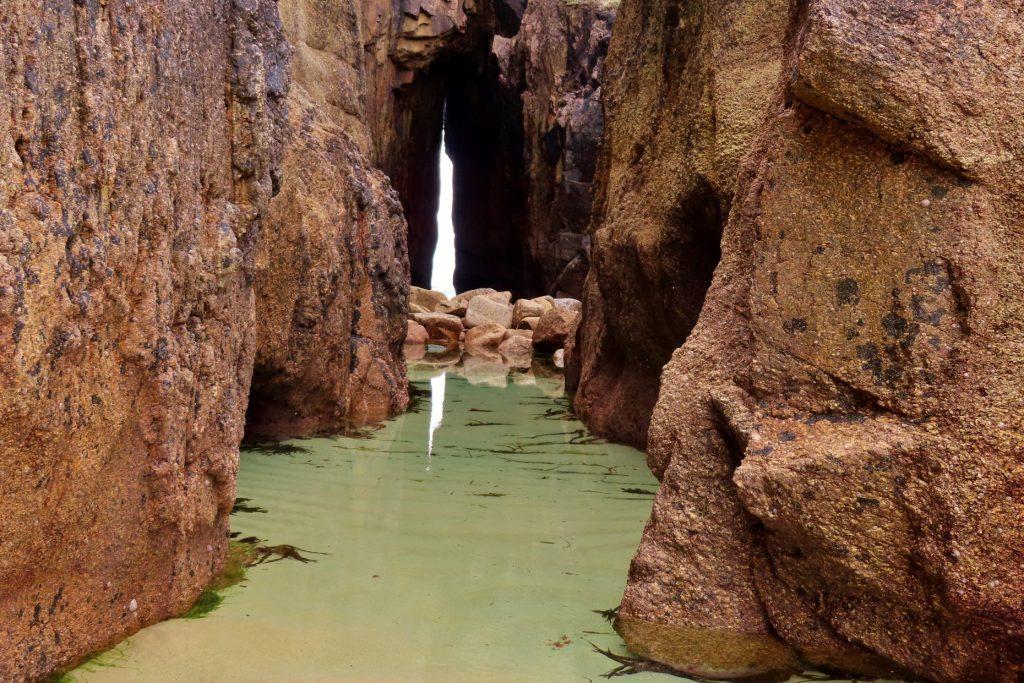
At high tide, the pools are entirely submerged, so make sure you plan your visit when the ocean is receded. Ensure the water is calm before you enter; again, there’s a risk of being pulled out to sea, so only strong swimmers should enter the water.
If you’re able to swim at the Sea Cave, it’ll be an experience that you’ll remember forever. Its magnificent beauty is truly unforgettable.
Stay Safe with Coasteering and Caving Tours
Cornwall is mostly surrounded by water, making for a brilliant coastline. It’s a dream location for coasteering and caving.
Coasteering “involves traversing along a stretch of intertidal zone, often as part of
an organised group activity. Participants travel across rocks and through water, using a variety of techniques including climbing, swimming and jumping into water.”
On the other hand, caving is less about the water and more to do with winding underground systems. It’s thrilling to explore the twists and turns within them, following set paths or discovering your own (as long as you remain safe, that is).
Coasteering and caving are activities that range in difficulty depending on the experience of the participants and the environment on hand.
For example, exploring a deep, dark, winding cave is much more dangerous than entering a wide, shallow cave.
Check out Kernow Coasteering to book guided tours and, and read more about Where to Go Coasteering in Cornwall.
If you’re more of the caving type, be sure to look into Cornwall Underground Adventures.
Time to explore under the rocks!
Cornwall is a coastal county lined with world-renowned caves. Man, myth, and nature collide when it comes to these hollow areas in the rock!
Cornwall’s caves are a result of long-term erosion and miners digging for minerals in a bygone era. Many of them come equipped with stories and myths that have developed over hundreds of years, passed down by Cornish locals.
Whether it’s sipping holy water at Holywell or swimming through the rectangular doorway on a cliff at Zawn Pyg, you’re simply spoilt for choice when it comes to picking a cave to explore.
Whatever you’re fancying, one thing’s for sure — visiting a cave in Cornwall is an experience that won’t leave you disappointed!

Introducing Eliot, the Editor here and Cornwall local with a wanderlust spirit and an insatiable appetite for adventure. With a passion for the great outdoors, he can often be found catching waves on his surfboard, scaling peaks on a hiking trail, or discovering hidden gems in his exploration of Cornwall.
